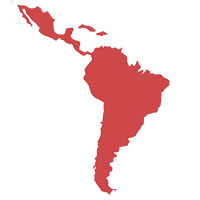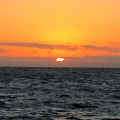Blue: the Colour of Climate Stability
Malcolm J | December 11, 2014.
Fading into darkness, the pictures of bears, whales, glaciers disappear and a hush falls over the crowd as Bernardo Sambra takes the stage. Along with the team at The Living Ocean, and with the support of the Peruvian government, Sambra calls for a moment of inspiration and action to save the world’s oceans.
The Frágile expo brings together work from 14 photographers about the world’s oceans. “There is no more time,” Sambra proclaims. He argues we have a moral duty to act now. Amongst all the pessimism in Lima, where climate talks are trundling along, Sambra argues “there is still hope,” particularly with oceans increasingly becoming central to international and national meetings.
Diving off the coast of Peru has been one of Sambra’s passions, but current trends are threatening this activity. Since 1950, the rise in ocean sea surface temperatures has resulted in a 40 per cent decline in phytoplankton, the foundation of the marine food web. These tiny organisms produce half the world’s oxygen and are the primary means of carbon dioxide absorption into oceans. Coupled with ocean acidification, deoxygenation, overfishing, some scientists have warned of the possibility world fish stocks collapsing by 2050.
Even if carbon emissions were eliminated overnight, the ocean would continue to absorb the excess heat and carbon, continuing to change its composition for hundreds, even thousands, of years.
Such massive challenges require new perspectives. Wallace J. Nichols, author of the New York Times bestseller Blue Mind, challenged an audience full of negotiators to transcend traditional applications of science and economics to focus on the science of emotion and of passion. If oceans are so inspirational, surely we can harness that power to protect them. Nichols called for everyone to imagine a conference without a focus on oceans, a conference that doesn’t recognise the importance of the blue in our pale blue dot.
Oceans became part of international negotiations earlier this year after the second annual Global Oceans Action Summit. Governments, business leaders and NGOs from 80 countries agreed to incorporate oceans in the climate change agenda leading up to the UN conference in Paris in 2015.
At a meeting of developing small island states this year, island forum leaders were called on as stewards of the Pacific Ocean to lead the global drive for a sustainable future. However, climate activists feared the worst when Ban Ki-moon’s Climate Summit failed to include the impact of climate change on oceans. One reason for omitting oceans could be because solutions to climate change have to be made on land.
“The world’s oceans are key to sustaining life on the planet. The ocean constitutes a conduit for 90 per cent of world trade, and for connecting people, markets and livelihoods. In light of the ocean’s interconnectedness, all nations of the world should strive to make the oceans places of safety and sustainability of maritime activities for all humankind.” – Ban Ki-moon, 2012
Travelling thousands of miles and crossing dozens of political borders, marine species reveal a valuable aspect of the ocean: interconnectivity. Painting a picture in the minds of those listening, Fabien Cousteau, ocean explorer and Mission 31 founder, reminded the audience that every impact to the ocean can change the entire system. Cousteau called for more education to help instil a sense of wonder of the ocean. Astonishingly, a mere five per cent of the sea floor has been explored. For Cousteau: “Only through the lens of adventure and education can we change the planet.”
Communicating the need to protect our seas is happening all over the world thanks to international organisations, governments and schools. More importantly, people are being reminded of the time in their lives they fell in love with the sea. Advances in technology allow us to explore parts of oceans never before experienced, bringing them to individuals that may never have the chance to visit. NGOs continue to urge governments to protect more of the seascape because healthy oceans mean healthier and happier people.
Unhealthy oceans mean less successful communities, particularly when fisheries begin to collapse due to changes in the climate. The Peruvian minister of production Piero Ghezzi warned fisheries are already being affected by increased temperatures, overfishing, and climatic events. He touted the ‘Ten Commitments Towards Sustainable Fisheries’ agreed upon earlier in the week, but was concerned climate change would interfere with sustainability efforts. “We must be anti-fragile,” he stated. Rather than be more resilient, we must “strengthen under stress.”
With more than 70 per cent of the world’s populations living near the coast, it is little wonder that fish supply the greatest percentage of proteins consumed by humans. Marine and coastal resources and industries also represent more than five per cent of global GDP. Oceans allow many industries to flourish, such fisheries, energy, tourism and shipping.
Oceans also provide ‘non-market’ benefits such as carbon sequestration, climate regulation, habitat and biodiversity. They provide opportunities for development of new drugs based on little known marine organisms, some of which have already found their way onto the market. Equally important, oceans are part of many cultures, whose beliefs and practices are closely associated with the marine and coastal environment.
During the welcoming reception of the UN climate change meeting in Lima, a presentation of the Moche culture of northern Peru took place in the ocean pavilion. The Moche believe that the god of the sea gave life to man and, in the same way, the ocean is the source of life.
Manuel Pulgar-Vidal, president of COP20 and Peruvian minister of environment, challenged everyone to think creatively so that we can protect marine areas while continuing production. “Oceans are at the heart of climate negotiations and will be featured at COP21 in Paris,” concluded Mr. Vidal. “Blue is the colour of the ocean. Blue is the colour of the sky. Blue is the colour of peace. Blue is the colour of climate stability.”
To an innocent bystander, it seems as though activists could talk about oceans until they were blue in the face. Then again, they would only be showing their true colours.













comment